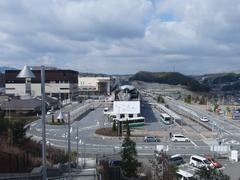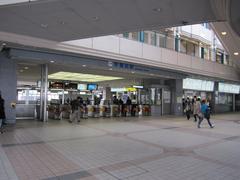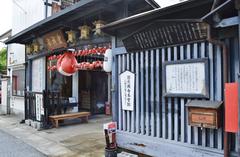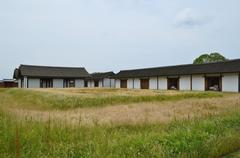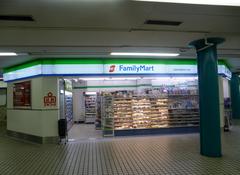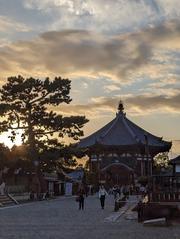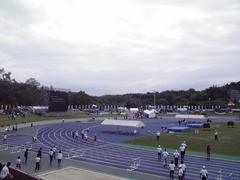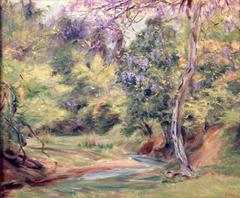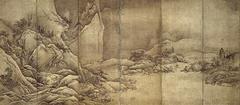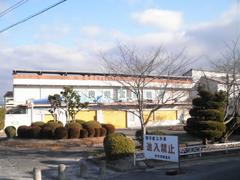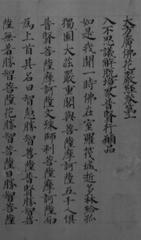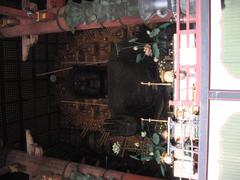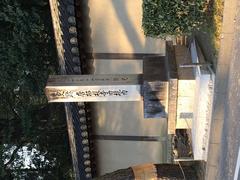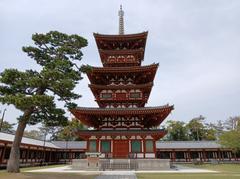Heijō Station Visiting Hours, Tickets, and Nara Historical Sites Guide
Date: 04/07/2025
Introduction
Nestled in the historic city of Nara, Japan, Heijō Palace (Heijō-kyū) symbolizes the dawn of Japan’s imperial era and stands as a monumental testament to the flourishing culture of the Nara period (710–794 CE). Once the political and cultural heart of the nation, the Heijō Palace Site is now a designated UNESCO World Heritage Site, offering visitors a rare opportunity to step back into Japan’s ancient past. This comprehensive guide will walk you through Heijō Palace’s profound historical importance, share practical visitor information—including visiting hours, ticketing, accessibility, and transportation via Heijō Station—and introduce the array of nearby attractions that will enrich your experience in Nara.
Whether you are fascinated by reconstructed halls like the Daigokuden (Imperial Audience Hall) and the iconic Suzaku Gate, or drawn to seasonal festivals and archaeological exhibitions, Heijō Palace offers a journey into Japan’s imperial legacy. With free admission to most areas, wheelchair-friendly paths, and multilingual resources such as the “Nara Heijokyo Historic Walk” app, your visit is designed to be both educational and accessible. Conveniently reached via Heijō Station on the Kintetsu Nara Line, the palace grounds serve as a gateway to Nara’s broader historical landscape, including renowned sites like Tōdai-ji Temple and Nara Park (Heijo Park; Japan Guide; Kanpai Japan).
Table of Contents
- Origins and Historical Context of Heijō Palace
- Political and Cultural Significance
- Decline, Rediscovery, and Preservation
- Visiting Heijō Palace: Hours, Tickets, and Accessibility
- How to Get to Heijō Palace
- Exploring Nearby Nara Historical Sites
- Key Reconstructions and Museums at Heijō Palace
- Frequently Asked Questions (FAQ)
- Summary and Final Travel Advice
Origins and Historical Context of Heijō Palace
Heijō Palace (Heijō-kyū) was the imperial residence and administrative center of Japan during the Nara period, marking the establishment of the nation’s first permanent capital at Heijō-kyō (modern-day Nara). The city’s design, inspired by the Tang dynasty’s capital, Chang’an, featured an orderly grid system with the palace complex situated at its northern end (Japan Guide).
Spanning approximately one square kilometer, the palace was surrounded by earthworks and moats, with twelve gates providing access to its inner sanctums. Inside, the emperor’s residence, government ministries, and ceremonial halls such as the Daigokuden (Imperial Audience Hall) and Chōdō-in hosted official business and state rituals (Heijo Park; Nara City Tourism Association).
Political and Cultural Significance
For 74 years, Heijō Palace was the epicenter of Japanese political life, introducing the Ritsuryō legal system and establishing a centralized bureaucracy influenced by Chinese governance. The palace hosted eight ministries and over 100 government agencies, reflecting an era of remarkable administrative sophistication (Nara City Tourism Association).
This period also witnessed the flourishing of Tenpyō culture, marked by the spread of Buddhism, monumental Buddhist art, and the compilation of Japan’s earliest historical chronicles. Heijō Palace served as the backdrop for diplomatic receptions, imperial ceremonies, and the enactment of foundational laws (Heijo Park).
Decline, Rediscovery, and Preservation
After the capital moved to Heian-kyō (Kyoto) in 784, Heijō Palace was gradually abandoned and eventually forgotten. Rediscovery began in the late Edo and early Meiji periods, with scholars and local advocates working to identify and preserve the site (Nara Blue).
Key preservation efforts culminated in the 1910 “1200th Anniversary Festival” and subsequent donation of the site to the state. Extensive archaeological research began in the 1950s, leading to the site’s designation as a Special Historic Site in 1952 and its inclusion as a UNESCO World Heritage Site in 1998 (Heijo Park; Japan Guide).
Visiting Heijō Palace: Hours, Tickets, and Accessibility
Visiting Hours
- April to October: 9:00 AM – 5:00 PM (last entry 4:30 PM)
- November to March: 9:00 AM – 4:30 PM (last entry 4:00 PM)
- Year-End Closure: December 28 to January 4
Some exhibition halls and museums may have different closing days or hours. It is advisable to check the official website before your visit.
Admission and Tickets
- General Admission: Free for the palace grounds and main reconstructions, including the Daigokuden and Suzaku Gate.
- Special Exhibitions: Some special exhibitions or events may require a small fee, clearly indicated online and on-site.
Accessibility
Heijō Palace offers paved, wheelchair- and stroller-friendly paths, accessible restrooms, and ramps at major points of interest. English signage and the free “Nara Heijokyo Historic Walk” app enhance the experience for international visitors (Visit Nara).
Guided Tours and Special Events
Guided tours are available in multiple languages, often led by knowledgeable local volunteers or professional guides. Seasonal events, such as the Heijō Palace Festival in October and the Heijō-kyō Tenpyō-sai Summer Night Festival in August, enrich the visitor experience with historical reenactments, illuminations, and cultural performances (Japan365Days).
How to Get to Heijō Palace
By Train
Heijō Station (平城駅, Heijō-eki) on the Kintetsu Nara Line is the most convenient access point. The palace is a 10–15 minute walk from the station.
- From Kintetsu Nara Station: 5-minute train ride to Heijō Station (approx. 240 yen).
- From Osaka Namba: Direct Kintetsu trains take about 30–35 minutes.
- From Kyoto: Transfer at Yamato-Saidaiji Station; total travel time is 45–50 minutes (The Backpacking Family).
By Bus
Bus number 14 from JR Nara Station or Kintetsu Nara Station stops near key palace sites, such as the Excavation Site Exhibition Hall and the Daigokuden. Buses run about twice per hour; fares are 290–330 yen (Japan Guide).
Travel Tips
- Visit on weekdays or early mornings to avoid crowds.
- Spring (cherry blossom season) and autumn (fall foliage) offer the most picturesque scenery.
- Wear comfortable shoes; the site covers a large area.
- IC cards like ICOCA and Suica are accepted for convenient fare payment.
Exploring Nearby Nara Historical Sites
Enhance your trip by visiting these renowned Nara attractions:
- Tōdai-ji Temple: Home to the Great Buddha, a short bus ride away.
- Nara Park: Famous for its friendly free-roaming deer and scenic walking trails.
- Kasuga Taisha Shrine: Renowned for its lantern festivals and spiritual ambiance (Matcha; Nomadasaurus).
Key Reconstructions and Museums at Heijō Palace
- Suzaku Gate (Suzakumon): The striking vermilion southern entrance, rebuilt to its original grandeur. Perfect for photography and understanding imperial processions (Japan365Days).
- Imperial Audience Hall (Daigokuden): The largest reconstructed building, showcasing the emperor’s throne and ornate ceilings decorated with celestial motifs (SakuraTrips).
- East Palace Garden (Toin Teien): A peaceful, restored imperial garden with a pond and bridges, beautiful in cherry blossom and autumn foliage seasons.
- Nara Palace Site Museum: Features artifacts such as wooden tablets (mokkan), models, and multimedia exhibits (SakuraTrips).
- Excavation Site Exhibition Hall: Offers views of ongoing archaeological digs and interpretive displays.
- Heijokyu Izanai-kan: Interactive exhibits on city planning and daily life in ancient Heijō-kyō (Nara Blue).
Heijō Station: Your Gateway to Nara’s Ancient History
Heijō Station serves as a vital access point for exploring Nara’s historical treasures, especially the Heijō Palace Site.
Transportation Hub
Located in northwestern Nara City, Heijō Station is served by the Kintetsu Nara Line, connecting to Osaka and Kyoto. Direct trains reach Osaka Namba in about 35 minutes and Kyoto Station via Yamato-Saidaiji in roughly 50 minutes (The Backpacking Family).
Station Facilities and Accessibility
Heijō Station is open daily from approximately 5:00 AM to midnight, featuring ticket machines with English support, IC card acceptance, elevators, ramps, accessible restrooms, and clear bilingual signage. Coin lockers and convenience stores add to visitor comfort (Kanpai Japan).
Practical Tips
- The 10–15-minute walk to Heijō Palace is along flat, well-marked pedestrian routes.
- Local buses connect to other major Nara sites.
- Spring and autumn are the best times to visit due to pleasant weather and beautiful natural surroundings.
Events and Festivals
- Heijō-kyō Tenpyō-sai Summer Night Festival: Traditional costume parades, fireworks, light displays, and live music in August (Japan365Days).
- Heijō Palace Festival: Cultural and historical reenactments, special exhibitions, and extended opening hours.
Guided Tours and Educational Experiences
- Guided tours are available in English and Japanese, offering in-depth historical interpretation.
- The Nara Palace Site Museum and Excavation Hall provide interactive exhibits for all ages (Evendo).
Frequently Asked Questions (FAQ)
Q: What are the Heijō Palace visiting hours?
A: 9:00 AM to 5:00 PM (April–October), 9:00 AM to 4:30 PM (November–March). Closed December 28 to January 4.
Q: Is there an admission fee?
A: General admission is free; special exhibitions may require a small fee.
Q: Are guided tours available?
A: Yes, in multiple languages. Book at the visitor center or online.
Q: How accessible is the site?
A: The site and station are wheelchair- and stroller-friendly, with accessible restrooms and signage.
Q: How do I get to Heijō Palace from Nara Station?
A: Take a 5-minute Kintetsu train to Heijō Station, then walk 10–15 minutes. Buses are also available.
Summary and Final Travel Advice
Heijō Palace is an indispensable destination for anyone seeking to understand Japan’s early imperial history. Its expansive grounds—featuring meticulously reconstructed buildings, serene gardens, and engaging museums—blend education, culture, and natural beauty. The site’s free admission, comprehensive accessibility, and informative guided tours make it welcoming to all. Heijō Station’s convenient access and clear signage ensure a smooth journey for visitors, while seasonal events like the Heijō-kyō Tenpyō-sai Festival provide unforgettable cultural moments.
Plan your visit around the best seasons, take advantage of digital tools like the “Nara Heijokyo Historic Walk” app, and consider exploring nearby landmarks such as Tōdai-ji Temple and Kasuga Taisha Shrine. Embark on your journey to Heijō Palace, where Japan’s ancient history is preserved, celebrated, and brought to life.
References and Official Links
- Heijo Park
- Kanpai Japan
- Japan Guide
- SakuraTrips
- Japan365Days
- The Backpacking Family
- Washoku Club
- Evendo
- Matcha
- Nomadasaurus
- Visit Nara
